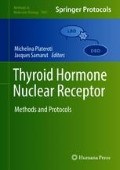Abstract
The ability of thyroid hormone T3 to stimulate energy expenditure and regulate different aspects of whole body metabolism has been recognized for over a 100 years. Indeed in 1895 Adolf Magnus Levy was already describing the influence of the thyroid on setting the basal metabolic rate. Now it has been well characterized that the level of circulating T3 is correlated with energy expenditure both in humans and in rodent models (Mullur et al., Physiol Rev 94:355–382, 2014; Silva, Thyroid 5:481–492, 1995). Hypothyroidism and hyperthyroidism are respectively associated with low and high energy expenditure leading to high and low body mass index. Moreover, T3 also reduces the level of cholesterol in the serum, which is one of the key risk factors to develop atherosclerosis (Mullur et al., Physiol Rev 94:355–382, 2014; Hak et al., Ann Intern Med 132:270–278, 2000). Given the worldwide pandemic of obesity and associated metabolic disorders in the last two decades, the metabolic activities of T3 gained a renewed interest. However, one has to keep in mind that despite its desirable actions, T3 cannot be used as a pharmacological agent since it also triggers unacceptable effects including tachycardia, lean mass loss, and osteoporosis. To solve this conundrum, a recent intense effort has been dedicated to understand how T3 fulfills its different activities, looking for the target tissues and the specific T3 receptor (TR) involved. Indeed recently it was shown that injection of T3 in the brain could efficiently trigger thermogenesis (López et al., Nat Med 16:1001–1008, 2010). This questioned the classical paradigm in which most metabolic actions were the result of local T3 action in the different metabolic tissues. To tackle this problem, many new models of transgenic mice carrying selective Knock-out and Knock-in mutation of TR in specific metabolic tissues are currently generated using conditional mutant alleles of THRA (Quignodon et al., Mol Endocrinol 21:2350–2360, 2007) and THRB (Billon et al., Endocrinology 155:2735–2745, 2014). In parallel some new compounds that allow the targeting of T3 to selective metabolic tissues (Finan et al., Cell 167:843–857, 2016) have also been obtained.
In this chapter we will provide and comment two different protocols that are useful to study the adaptive thermogenesis in response to two physiological stresses: cold exposure and high fat diet feeding. They can also be used to test the thermogenic activity of the new designed compounds.
Access this chapter
Tax calculation will be finalised at checkout
Purchases are for personal use only
References
Lowell BB, Spiegelman BM (2000) Towards a molecular understanding of adaptive thermogenesis. Nature 404(6778):652–660
Contreras C, Nogueiras R, Diéguez C et al (2017) Traveling from the hypothalamus to the adipose tissue: the thermogenic pathway. Redox Biol 12:854–863
Jimenez M, Léger B, Canola K et al (2002) Beta(1)/beta(2)/beta(3)-adrenoceptor knockout mice are obese and cold-sensitive but have normal lipolytic responses to fasting. FEBS Lett 530(1–3):37–40
Enerback S, Jacobsson A, Simpson EM et al (1997) Mice lacking mitochondrial uncoupling protein are cold-sensitive but not obese. Nature 387(6628):90–94
Bianco AC, Silva JE (1987) Intracellular conversion of thyroxine to triiodothyronine is required for the optimal thermogenic function of brown adipose tissue. J Clin Invest 79:295–300
Christoffolete MA, Linardi CC, de Jesus L et al (2004) Mice with targeted disruption of the Dio2 gene have cold-induced overexpression of the uncoupling protein 1 gene but fail to increase brown adipose tissue lipogenesis and adaptive thermogenesis. Diabetes 53(3):577–584
Virtanen KA, Nuutila P (2011) Brown adipose tissue in humans. Curr Opin Lipidol 22(1):49–54
Silva JE, Larsen PR (1983) Adrenergic activation of triiodothyronine production in brown adipose tissue. Nature 305(5936):712–713
Silva JE Larsen PR (1985) Potential of brown adipose tissue type II thyroxine 5′-deiodinase as a local and systemic source of triiodothyronine in rats. J Clin Invest 76(6):2296–2305
Broeders EP, Vijgen GH, Havekes B et al (2016) Thyroid hormone activates brown adipose tissue and increases non-shivering thermogenesis—a cohort study in a group of thyroid carcinoma patients. PLoS One 11(1):e0145049
Castillo M, Hall JA, Correa-Medina M, Ueta C et al (2011) Disruption of thyroid hormone activation in type 2 deiodinase knockout mice causes obesity with glucose intolerance and liver steatosis only at thermoneutrality. Diabetes 60(4):1082–1089
Author information
Authors and Affiliations
Corresponding author
Editor information
Editors and Affiliations
Rights and permissions
Copyright information
© 2018 Springer Science+Business Media, LLC, part of Springer Nature
About this protocol
Cite this protocol
Gauthier, K. (2018). Protocols for Studying How Thyroid Hormone Receptors Trigger Adaptive Thermogenesis in Mice. In: Plateroti, M., Samarut, J. (eds) Thyroid Hormone Nuclear Receptor. Methods in Molecular Biology, vol 1801. Humana Press, New York, NY. https://doi.org/10.1007/978-1-4939-7902-8_10
Download citation
DOI: https://doi.org/10.1007/978-1-4939-7902-8_10
Published:
Publisher Name: Humana Press, New York, NY
Print ISBN: 978-1-4939-7901-1
Online ISBN: 978-1-4939-7902-8
eBook Packages: Springer Protocols

